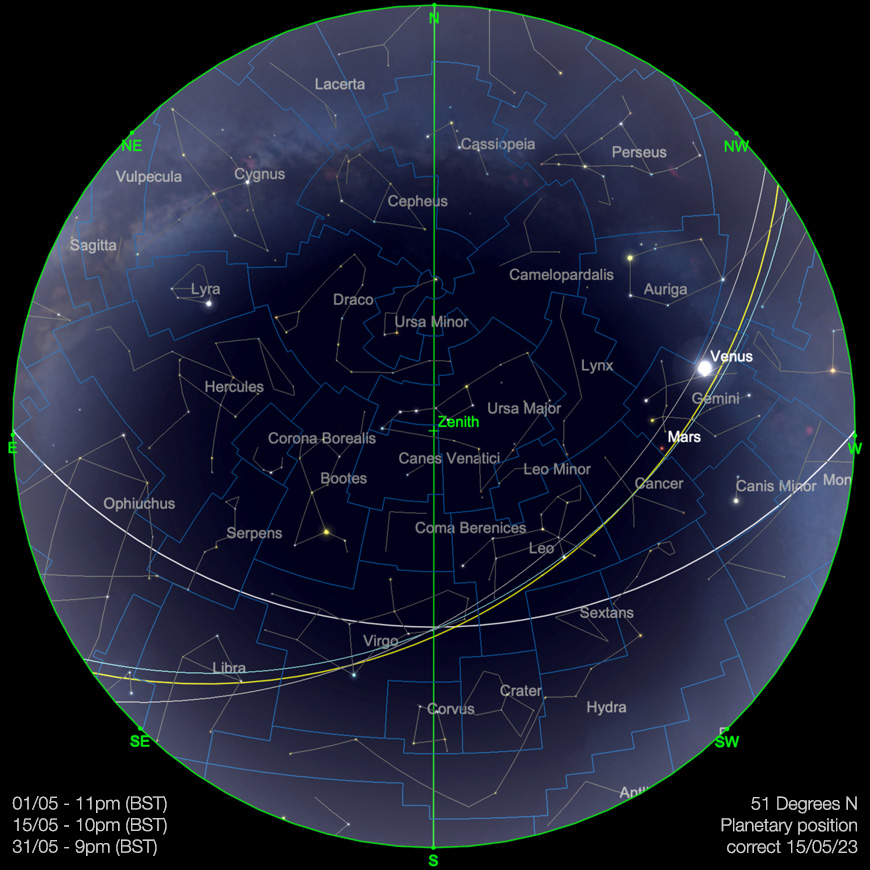Telescope House May Sky Guide
As we enter May, we find ourselves less than two months away from the Northern Hemisphere Midsummer, and conversely, Midwinter for those in the Southern Hemisphere. This transition has some implications for readers residing at higher mid-northern latitudes, particularly in Northern Europe and North America. The Earth's angle of rotation in relation to the plane of our Solar System causes a rapid decrease in true darkness for those at mid-to-high northern latitudes. On May 1st, for those around 50 degrees latitude N, astronomical dusk commences just before 11 pm and ends just past 3 am. Two weeks later, on May 15th, astronomical dusk starts at 11:46 pm and ends at 2:11 am. By the end of the month, there is no astronomical dusk and dawn for individuals residing at this latitude, as the Sun never sets more than 18 degrees below the horizon, and true astronomical darkness is never attained. This has an impact on the observation and astrophotography of fainter deep sky targets but fortunately does not affect brighter solar system objects.
The Solar System
The Moon
We start May with the Moon at 85% illuminated Gibbous phase in Virgo. Rising at a little before 4pm (BST) and transiting at a little before 10.30pm, it will be around for much of the night. The Moon will take a few days to cross the expanse of Virgo, expanding its phase as it does, until it reaches Full, having crossed over the border into neighbouring Libra. This Full Moon coincides with a lunar penumbral eclipse this month. Sadly, this particular eclipse is not optimally timed for observations from Europe - favouring Australasia, East Asia and the Eastern Pacific, China and the Indian subcontinent. The Moon will rise eclipsed from large parts of Europe and Africa, though the extreme west of Europe (including the British Isles) will only catch the absolute tail-end of the event at moonrise. Still, if you have a decent eastern horizon, it will be interesting to see how deep the eclipse appears. Some penumbral eclipses are barely noticeable, while others are actually quite deep (though never as much as a total lunar eclipse). The depth of a penumbral eclipse can give some indication of the health (or otherwise) of the Earth’s atmosphere - with eclipses just after major volcanic eruptions having been noted as especially dark. The whole event will be over by just before 10pm (BST), so while it may be a challenge to observe from certain areas, this eclipse does not fall in the wee small hours, so will at least be observable at a clement hour of the evening.
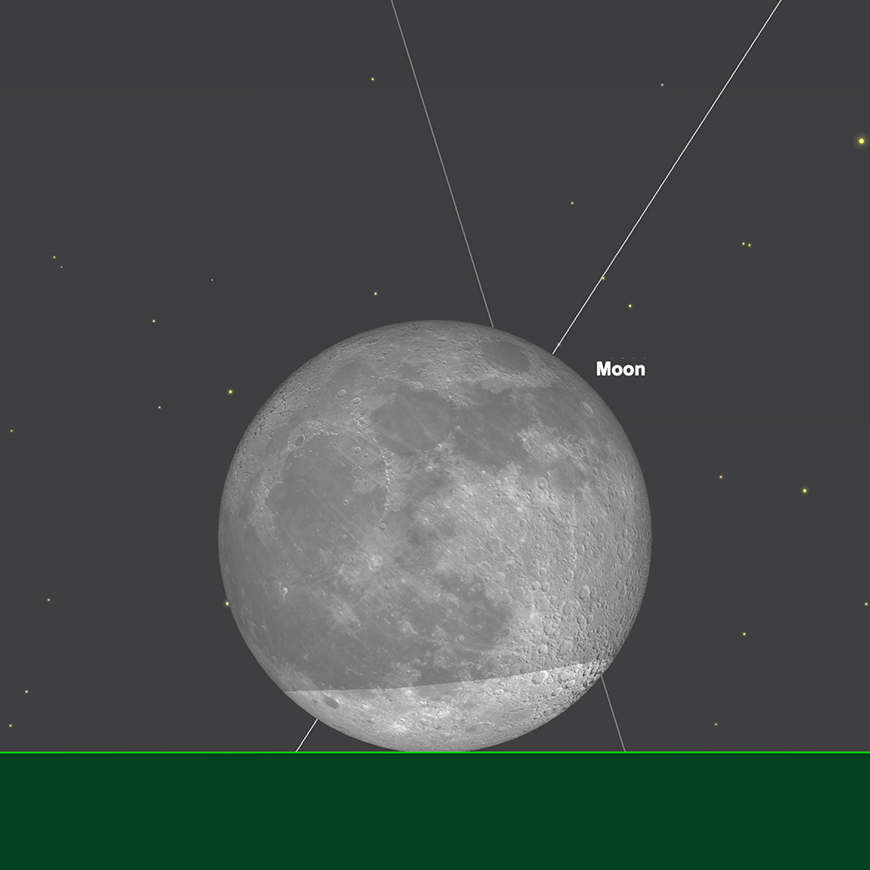
The Moon rising eclipsed, 8.49pm (BST), 5th May. Image created with SkySafari 5 for Mac OS X, ©2010-2016 Simulation Curriculum Corp., skysafariastronomy.com.
After the potential excitement of the eclipse, the Moon continues its journey through the southern part of the Ecliptic, waning as it does. The Moon reaches Last Quarter phase on the 12th, when it can be found in Capricornus and can be found sliding to the south of Saturn in the morning sky on the mornings of the 13th and 14th.
On the morning of the 17th, the tiny sliver of the 7% illuminated Crescent Moon joins Jupiter on the Pisces/Aries borders as the Sun rises. Two days later, the Moon joins the Sun in Taurus and becomes New. This would normally be the time we would point out the advantage of this time of the month for deep sky imaging and observations, but the latter part of May, finds many higher northern latitude observers already in a state of permanent astronomical twilight, which curtails the quality of observations and imaging of fainter targets somewhat.
The Moon emerges from New phase as an evening crescent and passes upwards from Taurus into Gemini, where it joins Venus in the twilight sky on the evening of the 23rd. The two will form a very attractive pairing as the Sun goes down, separated from each other by under 3 1/2 degrees. The following evening, the Moon will be found to the north of the very much fainter Mars - the two bodies separated by just over 3 degrees. The Moon is still quite high in the evening sky at crescent phase at this time of year, though a little less pronounced than it has been of recent months.
The Moon reaches First Quarter phase on 27th May, while a resident of Leo. It will transit at just after 7:30 pm (from 51° N), and will set at 2:30, the following morning.
The Moon crosses over the border from Leo into neighbouring Virgo on 29th May, where it will remain for the rest of the month. May ends on the 31st, with the Moon at 87% illuminated Waxing Gibbous phase.
The Sun
Our parent star continues its upwards trend towards solar maximum, which is generally thought to reach its current peak in 2025. We have an active Sun at present and plenty to see on it. Up to date trends Solar trends and more can be found at Michel Deconninck's website here: https://astro.aquarellia.com/doc/Summer2023.pdf
We have also been fortunate enough to have recently had a rather magnificent display of low latitude Aurora, which has made news headlines. Lower latitude aurora is difficult to predict in advance with any great accuracy, but as solar activity continues to rise, the chances of major auroral displays do concurrently. It's worth keeping an eye on a few of the popular sites devoted to solar astronomy, such a Space Weather, for up-front predictions of activity.
Mercury
The innermost planet begins May a couple of days before Inferior Conjunction (where in inner planet is found between the Earth and the Sun) and as such will be unobservable into the re-emerges from the solar glare.
By mid-month, Mercury has increased its angular distance from the Sun to just over 19°, though is still showing a very slight 15% illuminated phase and as such will remain relatively faint at +1.9 magnitude. Compounding this from northern climes, is the fact that Mercury is rising in a very shallow-rising part of the Ecliptic, as seen from temperate northern hemisphere locations, such as Europe. Even after Mercury reaches maximum western elongation on 29th May, the planet is still poorly-placed for observation in the morning. By the end of May, the planet will stand just over 6° in elevation at sunrise (from 51° north), so will be a very challenging target from the temperate northern hemisphere. By this point, it will have brightened somewhat to +0.4 magnitude, but will be much better-seen from the equatorial and tropical regions of the planet. The nearby Jupiter will act as a reasonable guide for the area of sky Mercury is to be found in in late May, but observers will need a very clear easterly horizon and good atmospheric conditions to be able to make a positive identification of the much fainter inner planet, as it remains stubbornly low in the morning sky.
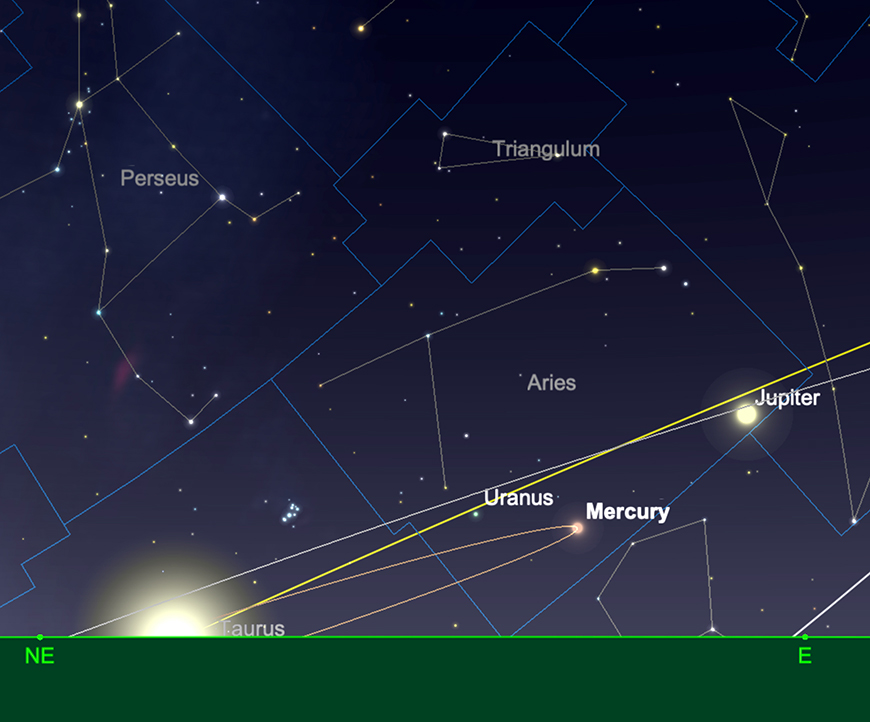
Mercury at sunrise, 31st May. Image created with SkySafari 5 for Mac OS X, ©2010-2016 Simulation Curriculum Corp., skysafariastronomy.com.
Venus
Whereas Mercury is disappointing during May, Venus is anything but. The 1st of May finds Venus standing at over 34° high (from 51° north) at sunset, almost due west, in the constellation of Taurus. At this point in time, the planet will be a dazzling -4.1 magnitude, displaying a 66% illuminated, 17 arc second diameter disc.
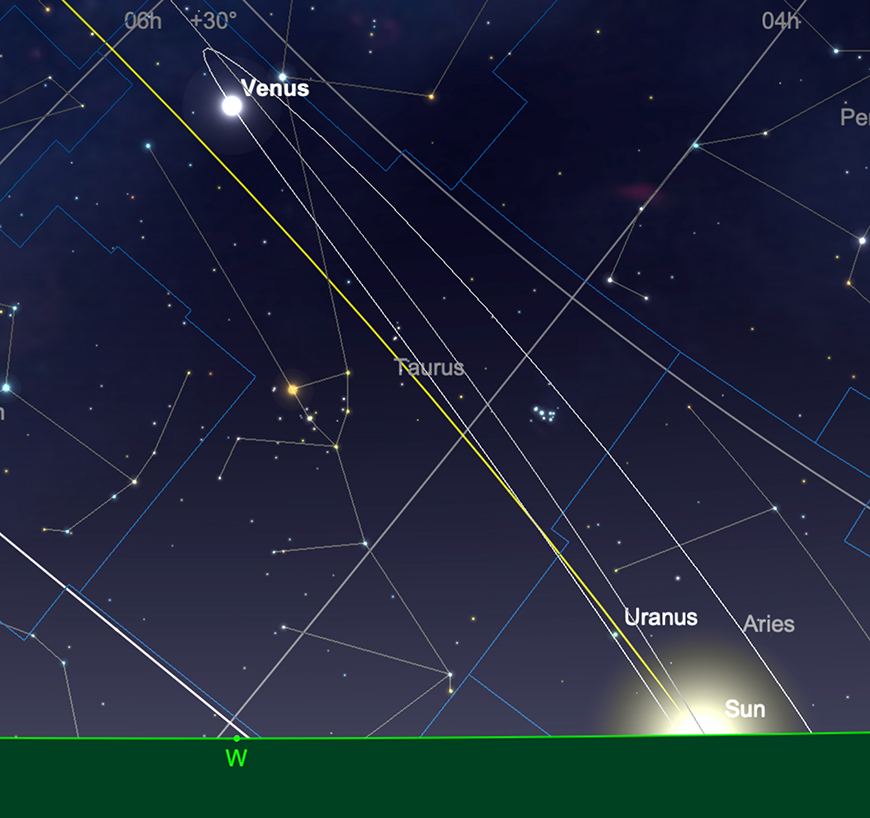
Venus at sunset, 1st May. Image created with SkySafari 5 for Mac OS X, ©2010-2016 Simulation Curriculum Corp., skysafariastronomy.com.
Venus is heading towards maximum eastern elongations, which it will reach in early June. The upshot of this is that Venus’ phase will start to rapidly diminish over the next few weeks and will shrink further as the planet rounds its orbit towards us here on Earth. The planet’s phase should be fairly easy to spot in smaller, telescopes and binoculars and observers are encouraged to keep a track of the changes over the next month, or so. Observing Venus can be a challenge, as it is so bright and condensed as an object. For those with telescopes, we would always recommend filtration, either neutral density filters, which help dial down the glare from the planet and can be useful in revealing its phase in more detail, or coloured filters Such as the Number 47 Minus Violet filter, which those with larger telescopes can use to try and glimpse the elusive cloud detail of Venus, at higher magnifications.
By the time we get to mid-May, Venus will have increased its brightness fractionally, to -4.2 magnitude. The planet will also have increased its diameter to 19 arc seconds, and now displays a phase of 59% illumination. Venus will sit at an altitude of 33° above the horizon at sunset on the evening of the 15th (again, from 51° north). As Venus has now crested over the very highest point in the northern ecliptic, it will slowly start to lose altitude in the evening sky. This will only be a gradual process, but the early part of May really represents the best opportunity this year for those of us in the northern hemisphere to observe Venus at its highest, so readers are encouraged to make the most of this.
The end of May finds Venus in the constellation of Gemini. It has fractionally increased its brightness yet again, to -4.3 magnitude and now displays a 22.6 arc second diameter disc, which is illuminated by just under 52%. The planet will sit at just over 29 1/2° above the horizon at sunset (from 51° north).
Mars
Where Venus is brilliant and increasing its brightness, Mars, which is to be found a little to the east in Gemini at the month’s beginning, is anything but. At +1.4 magnitude, on the evening of the 1st of May, the Red Planet is around the same brightness as Castor, and Pollux, twin stars of Gemini, which are to be found a little to the north of the planet. At just 5.3 arc seconds diameter, Mars is now a very diminutive target and it will require a large telescope and significant magnification to show any surface detail on its tiny disc.
By the middle of May, Mars has dimmed fractionally to +1.5 magnitude and now displays a 5 arc second diameter disc. The planet will be at very reasonable separation from the horizon, as seen from the temperate northern hemisphere. Mid-month sees Mars sitting at just under 43° elevation at sunset (as seen from 51° north). However, despite being well-situated, the planet remains a poor target and the trend is most definitely downwards as far as Mars is concerned.
By the time we get to the end of May, Mars has dimmed yet further to +1.6 magnitude and now displays a 4.7 arc second diameter disc. The brighter Venus can be used as a signpost to where Mars now lies, 11 degrees to the east, in the constellation of Cancer. However, Venus is a much more attractive target at present and observers are advised to concentrate on this. Mars ends May in central Cancer, sitting just half a degree to the west of the famous Beehive Cluster, M44. The two objects will be easily visible in the same binocular field in the early evening.
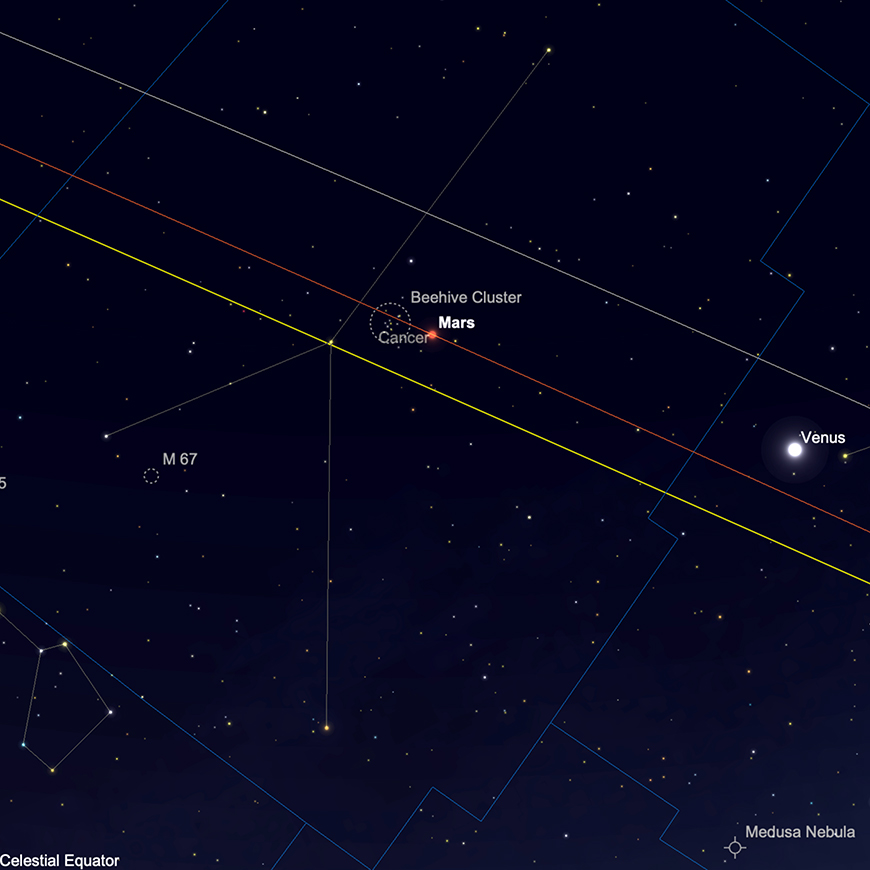
Mars and the Beehive Cluster, 31st May. Image created with SkySafari 5 for Mac OS X, ©2010-2016 Simulation Curriculum Corp., skysafariastronomy.com.
Jupiter
Now emerging from April’s Superior Conjunction, Jupiter is a morning target in Pisces at the beginning of May. On the morning of the 1st, Jupiter displays a -2.0 magnitude, 33.3 arc second diameter disc. As seen from 51° North, the planet only rises to an altitude of just under 3° as the Sun rises, so while separated from our parent star by over 14 degrees, will remain a very tricky, if not impossible object to observe from higher northern latitudes.
Moving on a couple of weeks to mid-month, we find Jupiter having increased its angular separation from the Sun to a little over 24°. The planet is also fractionally brighter, at -2.1 magnitude and is now showing a 33.7 arc second diameter disc. It will sit a little higher in the sky at sunrise, at an elevation of just under 7° high (as seen from 51° north).
By the time we make it to the end of May, Jupiter will have crossed over the border from Pisces into neighbouring Aries. The planet will remain static in brightness at -2.1 magnitude, though will have increased its altitude significantly from the month’s beginning, to sit at around 12 1/2° elevation (again, as observed from 51° north), as the Sun rises. Jupiter will sit at a separation of just over 36° from the Sun on the morning of the 31st. While the planet has some way to go in terms of gaining altitude, to reach the point where meaningful higher power observations can be easily made, from now on, Jupiter should be relatively easily-observable in telescopes (albeit with a limited observing window). However, observers are encouraged to keep magnifications sensible, so as to avoid the inevitable disruption that atmospheric conditions will wreak upon Jovian observations. Another couple of months and Jupiter will be in a much better position in the morning sky for northern hemisphere observations.
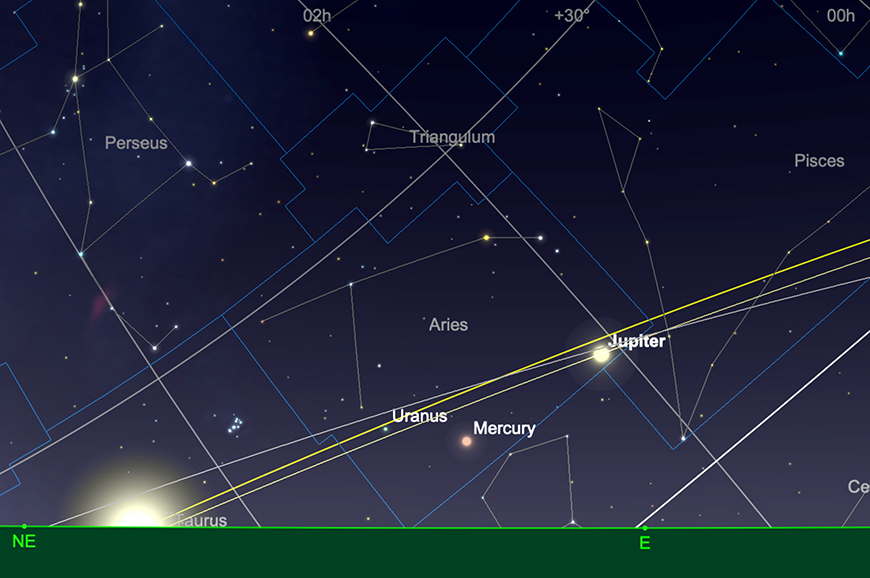
Jupiter, sunrise, 31st May. Image created with SkySafari 5 for Mac OS X, ©2010-2016 Simulation Curriculum Corp., skysafariastronomy.com.
Saturn
Saturn sits much further to the west of the Sun in the morning sky than its neighbour Jupiter and subsequently, rises much earlier and attains a greater height above the horizon before sunrise. The morning of the 1st May finds Saturn sitting a little under 15° elevation in the Southeast, displaying a +1.0 magnitude, 16.3 arc second diameter disc.
By the time we get to mid-month, not much is changed as for Saturn is concerned. The planet is still the same brightness as it was at the month’s beginning, though has increased its angular diameter to 16.7 arc seconds. The planet will rise a little after 3am and will attain a height of just over 18 1/2 degrees above the horizon (from 51° North), as the Sun rises.
By the time we get to the end of May, Saturn has increased its diameter to 17.1 arc seconds, though remains static in brightness at +1.0. It will stand over 24 degrees above the horizon in the SE as the Sun comes up, as seen from 51° North. Those turning a telescope towards Saturn and picking it up again after its recent Superior Conjunction and subsequent disappearance from view, will notice that its ring system is definitely closing and is noticeably thinner than it has appeared in recent years. This is all part of the natural cycle of how Saturn’s rings appear from Earth. In early 2025, we will cross Saturn’s ring plane and they will briefly disappear from view.
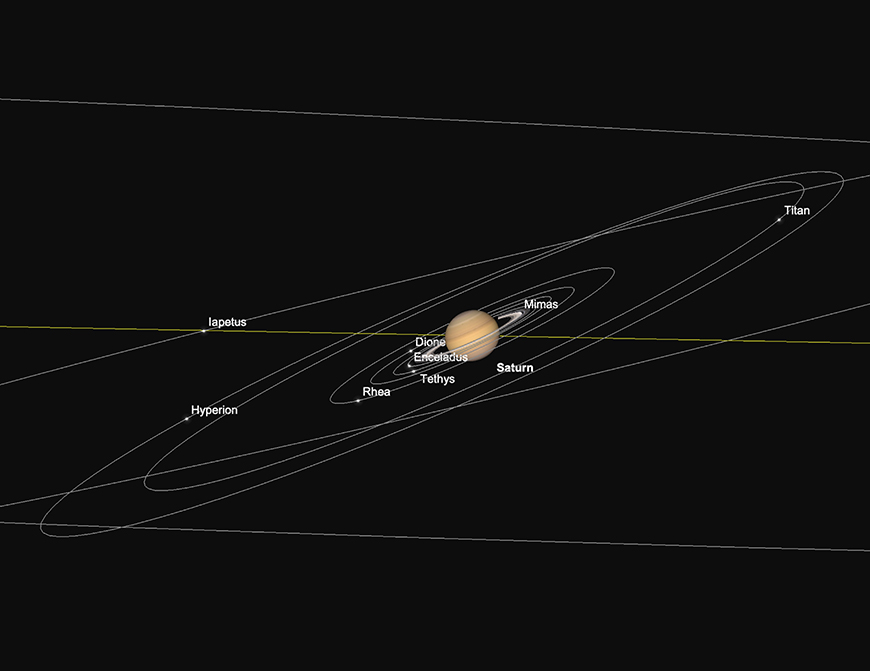
Saturn and inner moons, sunrise, 31st May. Image created with SkySafari 5 for Mac OS X, ©2010-2016 Simulation Curriculum Corp., skysafariastronomy.com.
Uranus and Neptune
Uranus will reach superior conjunction on 9th May, and will subsequently be unobservable for most of the month, eventually re-emerging as a morning target. However, it will be sometime after the end of May before it has increased its angular separation from the Sun and can be easily observed again.
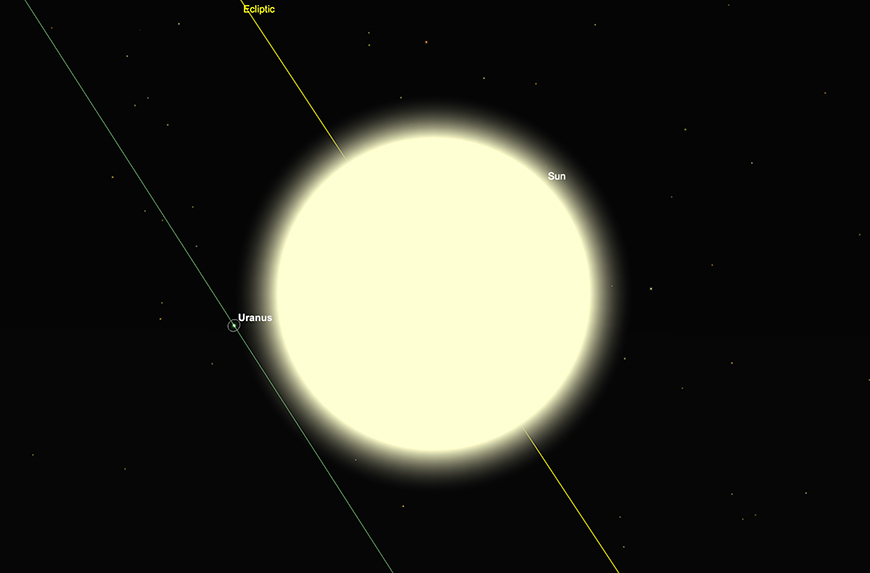
Uranus at Superior Conjunction, 9th May. Image created with SkySafari 5 for Mac OS X, ©2010-2016 Simulation Curriculum Corp., skysafariastronomy.com.
Neptune, being further west in the ecliptic has already been through the process of Superior Conjunction, which it reached in March. A resident of Pisces, it is now closer to being observable again. However, the permanent astronomical twilight at this time of year and the altitude of the planet in the morning still does not favour meaningful observation. It will be a little while yet before Neptune is in a better position to be observed from the temperate northern hemisphere.
Comets
There are no comets brighter than 9th/10th magnitude at present. The brightest of these, C/2017, K2 (PanSTARRS), is fading and is most definitely a southern hemispherical observer’s object. The next comet which shows reasonable potential is C/2019 T4 (Atlas), though it will be a good few months before it reaches maximum brightness in the late summer, by which time it will be only observable from the southern hemisphere. While we have potential delights of C/2023 A3 to come, this is still a considerable distance from the Sun and the comet has a long way to go on its journey before reaching the inner solar system. Further observations are needed to be able to determine if it is really going to be a naked eye spectacle, or just a decent binocular comet. This shower is seeded by the famous Halley’s Comet, whose debris is quite fast-moving, resulting in bright, energetic meteors. The best of these will be visible, but this year’s shower won’t be a classic by any means.
Meteors
Reaching their upper range of activity in early May, the Eta Aquariids meteor shower peaks on the night of May 5th/6th this year. While the zenith hourly rate of this shower - around 50 at maximum, this year - is not as high as some of the major annual showers, this event would be worth staying up for (or at least attempting to record photographically), where it not for the pernicious influence of the Moon, the perennial upsetter of meteor shower observation, which will be at 100% phase - Full Moon - and hanging around all night in Virgo. Sadly, this makes this year’s Eta Aquariids, somewhat of a washout. The very brightest meteors will cut through moonlight and scattered glare, but in truth, there will be better opportunities for observing meteor showers this year.

 English
English

